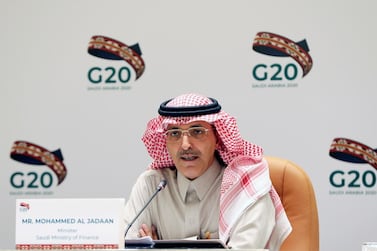Saudi Arabia’s central bank reaffirmed its commitment to its exchange rate policy of pegging its currency, the riyal, to the US dollar.
The Saudi Arabian Monetary Authority said pegging the riyal to the world’s biggest reserve currency was “a strategic choice that has supported economic growth in Saudi Arabia for over three decades” in a statement on its website on Monday.
“Furthermore, Sama remains committed to maintaining the exchange rate at the official rate of 3.75 riyals (Dh3.67) to the dollar as an anchor of monetary and financial stability,” the authority said.
Speculation by global currency investors about Riyadh’s commitment to maintaining the US dollar peg has occurred a number of times in recent years, usually in times of low oil prices as the kingdom generates a significant portion of its revenue through oil. Late last month, one-year dollar/riyal forward rate rose by as much as 264.3 points (or 2.64 cents), the highest level since November 2017, according to Reuters.
Yet despite a $24 billion (Dh88.1bn) drawdown of its foreign currency reserves in March, the Saudi Arabia's reserves “remain sufficient to meet all demands of the national economy for foreign exchange ... covering 43 months of imports”, Sama said.
It described the peg as “a primary driver for monetary stability and sustainable economic growth”.
The kingdom's foreign exchange reserves declined last month as it embarked on economic stimulus measures to protect its economy during the Covid-19 outbreak at the same time that revenue took a hit due to lower oil prices.
However, Saudi Arabia still had $473bn of foreign reserves at the end of March, according to investment bank Jadwa, which said in a note on Monday that “we do not expect similar reserve drawdowns going ahead”.
According to the head of the International Monetary Fund, investors withdrew about $100bn from emerging markets in February and March as fears about the economic impact of the coronavirus grew, outpacing the levels out outflows seen during the last financial crisis in 2009.
However, the outflows reversed in April, according to a research note from the Institute of International Finance on Monday, with inflows to emerging equity capital markets reaching $2bn and debt market inflows hitting $15.1bn. Saudi Arabia raised $7bn through a new bond issue last month, which was heavily oversubscribed, with $54bn of orders being placed, according to Bloomberg.








